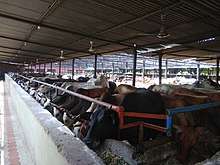Goshala
Gaushalas or Goshalas (Hindi: गौशाला, romanized: gauśālā) are protective shelters for cows in India. Goshalas focus on treating cows well, because of their religious significance in Hinduism and consequent cultural sensitivity towards their welfare.

Description
Goshala, a Sanskrit word ("Go" means cow and "Shala" means a shelter place: Go + Shala = shelter for cows), means the abode or sanctuary for cows, calves and oxen.[1]


History
India's first goshala is thought to have been established in Rewari by Raja Rao Yudhishter Singh Yadav.[2][3] There are now goshalas all over India.
The first Gaurakshini sabha (cow protection society) was established in the Punjab in 1882.[4] The movement spread rapidly all over North India and to Bengal, Bombay, Madras presidencies and other central provinces. The organization rescued wandering cows and reclaimed them to groom them in places called gaushalas. Charitable networks developed all through North India to collect rice from individuals, pool the contributions, and re-sell them to fund the gaushalas. Signatures, up to 350,000 in some places, were collected to demand a ban on cow sacrifice.[5] Between 1880 and 1893, hundreds of gaushalas were opened.[6] Today, Punjab Gaushala Mahasangh coordinates these activities in the Punjab.
United Kingdom
The UK's only Goshala is New Gokul, located at the Hare Krishna temple in Bhaktivedanta Manor.[7][8]
United States of America
The USA's first Goshala started at Gita Nagari Farm and Sanctuary, located in Port Royal, Pennsylvania.[9] Another major Goshala is operating in Florida under the name International Society for Cow Protection (ISCOWP). Lakshmi Cow Sanctuary is located in Stroudsburg, PA.
Goshala in Arizona: It was established on April 7, 2010 in Maricopa, and later relocated in San Tan Valley, since February 1, 2012.;[10][11]
Government support
Between 2014 and 2016 the Indian government spent 5.8 billion rupees (US$87 million) on cow shelters.[12]
To prevent unproductive cows being sent to the abattoir, the government started the Rashtriya Gokul Mission in mid-2014, a national program that involves constructing havens for retired cows. Proceeds from the animals’ bodily waste are intended to pay for their upkeep. In May 2016 the Indian national government held an inaugural national conference on goshalas.
See also
- Cow protection movement, India
- Cattle slaughter in India
- Cattle in religion
- Jainism
- Hinduism
- Brahman
References
- "300 cattle head for goshala everyday". Times Of India. 2011-08-17. Retrieved 2013-02-06.
- Rastogi, Nawal Kishore (2002-04-27). "In stoic silence, historical tanks of Rewari await tourists". Tribune India. Retrieved 2014-01-06.
- Satish Chandra Mittal (1986). Haryana, a Historical Perspective. Atlantic Publishers & Distri. pp. 4–. GGKEY:WZ4ZX97B5N2.
- The Making of an Indian Metropolis, Colonial governance and public culture in Bombay, 1890/1920, Prashant Kidambi, p. 176, ISBN 978-0-7546-5612-8.
- Vishnu's crowded temple, India since the great rebellion, pp. 67-69, Maria Misra, 2008, Yale University Press, ISBN 978-0-300-13721-7.
- "Report of the National Commission on Cattle - Chapter I (10. Beginning of mass protests against cow-killings)". Dahd.nic.in. Archived from the original on 27 September 2013. Retrieved 10 November 2013.

- "Grand Opening Of The Five Star Hilton For Krishna Cows". ISKCON News. 2010-11-12. Retrieved 2014-01-06.
- Das, Radha Mohan (2010-11-13). "New Farm Complex at Bhaktivedanta Manor". Vina.cc. Archived from the original on 2014-01-06. Retrieved 2014-01-06.
- http://www.theyogafarm.com/2016/05/working-farm-retreats-at-gita-nagari.html
- https://issuu.com/timespub/docs/1016_se_mesa_book/1?e=8633901/39735650
- https://www.facebook.com/azgoshala/?fref=ts
- "Cow urine can sell for more than milk in India". Bloomberg.com. 2016-07-18. Retrieved 2016-09-18.